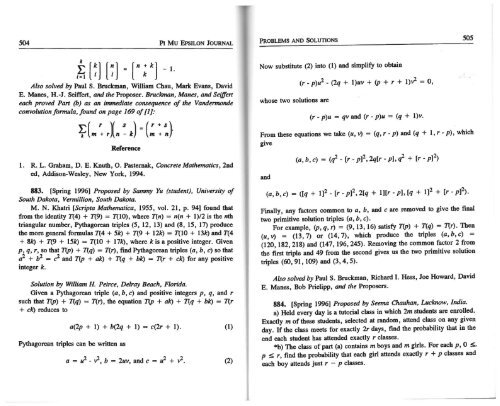Vol. 10 No 6 - Pi Mu Epsilon
Vol. 10 No 6 - Pi Mu Epsilon
Vol. 10 No 6 - Pi Mu Epsilon
- No tags were found...
Create successful ePaper yourself
Turn your PDF publications into a flip-book with our unique Google optimized e-Paper software.
504 PI <strong>Mu</strong> EPSILON JOURNAL<br />
PROBLEMS AND SOLUTIONS 505<br />
<strong>No</strong>w substitute (2) into (1) and simplify to obtain<br />
Also solved by PaulS. Bruckman, William Cbau, Mark Evans, David<br />
E. Manes, H.-J. Seiffert, and the Proposer. Bruclaru:ln, Manes, and Seiffert<br />
each proved Part (b) as an immediate consequence of the Vandemwnde<br />
convolution formula, found on page 169 of [1]:<br />
Reference<br />
1. R. L. Graham, D. E. Knuth, 0. Pasternak, Concrete Mathematics, 2nd<br />
ed, Addison-Wesley, New York, 1994.<br />
883. [Spring 1996] Proposed by Sammy Yu (student), University of<br />
South Dakota, Vermillion, South Dakota.<br />
M. N. Khatri [Scripta Mathematica, 1955, vol. 21, p. 94] found that<br />
from the identity 7'(4) + 7'(9) = T(lO), where T(n) = n(n + 1)/2 is the nth<br />
triangular number, Pythagorean triples (5, 12, 13) a11d (8, 15, 17) produce<br />
the more general formulas T( 4 + 5k) + T(9 + 12/c) = T( <strong>10</strong> + 13k) and T( 4<br />
+ 8k) + T(9 + 15k) = T(lO + 17k), where k is a positive integer. Given<br />
p, q, r, so that T(p) + T(q) = T(r), find Pythagorean triples (a, b, c) so that<br />
a 2 + b 2 = dl and T(p + ak) + T(q + bk) = T(r + ck) for any positive<br />
integer k.<br />
Solution by William H. Peirce, Delray Beach, Florida.<br />
Given a Pythagorean triple (a, b, c) and positive integers p, q, and r<br />
such that T(p) + T(q) = T(r), the equation T(p + ak) + T(q + bk) = T(r<br />
+ ck) reduces to<br />
a(2p + 1) + b(2q + 1) = c(2r + 1). (1)<br />
Pythagorean triples can be written as<br />
a = u 2 - v2, b = 2uv, and c = u 2 + v2. (2)<br />
whose two solutions are<br />
(r- p)u 2 - (2q + 1)uv + (p + r + l)v2 = 0,<br />
(r - p)u = qv and (r - p)u = (q + 1)v.<br />
From these equations we take (u, v) = (q, r- p) and (q + 1, r- p), which<br />
give<br />
and<br />
(a, b, c) =
















